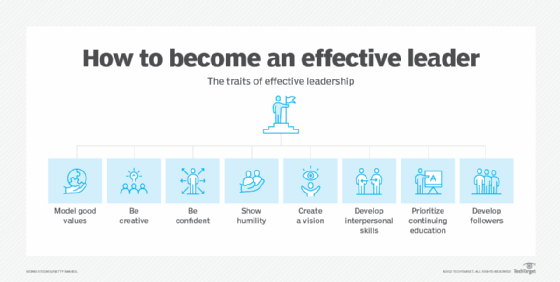strategic leadership
What is strategic leadership?
Strategic leadership is a practice in which executives, using different styles of management, develop a vision for their organization that enables it to adapt to or remain competitive in a changing economic and technological climate. Strategic leaders can use this vision to motivate employees and departments, fostering among them a sense of unity and direction to implement change within their organization.
The main objectives of strategic leadership are to streamline processes, boost strategic productivity, promote innovation and cultivate an environment that encourages employees to be productive, independent and to push forward their own ideas. Strategic leaders sometimes make use of reward or incentive programs to encourage employees and help them reach their goals.
The strategic leadership process
Leaders must first understand their organization's mission to be strategic. This means fully grasping why the company exists, who its customers are and how exactly it can provide value for them.
Then strategic leaders need to create a vision of what that mission will look like at a specified time in the future.
Finally, leaders must craft a strategy to put that vision into action. The strategy should map out the steps a company needs to take or the changes it needs to make to get from its current state to its desired state.

Strategic leadership skills and characteristics
Strategic leaders ideally have the ability to challenge prevailing viewpoints without provoking significant pushback, to see the big and small picture at the same time, to adapt to marketplace changes and take advantage of new opportunities, to make difficult decisions, to balance an analytical perspective with the human dimension of strategy building, and to advocate for and engage with employees.
Key traits of an effective strategic leader include loyalty to the organization's vision, judicious use of power, transparency, effective communication, problem-solving, readiness to delegate, passion for their job, compassion, empathy for others and self-awareness.
According to Harvard Business Review, strategic leadership competencies include the following six essential skills:
- Anticipate. Collect information from a wide range of sources both inside and outside your company's industry or function to predict competitors' moves and reactions to new initiatives or products.
- Challenge. View and reframe a problem from multiple angles to understand its underlying causes.
- Interpret. Exhibit curiosity and openness when testing several working hypotheses and involve others before coming to any conclusions.
- Decide. Weigh long-term investments for growth with short-term pressure for results as well as the risks and tradeoffs for customers and other stakeholders, when making decisions.
- Align. Examine stakeholders' incentives and tolerance for change and identify conflicting interests.
- Learn. Convey stories of success and failure to advocate learning. Course-correct decisions after they have been made if there is refuting evidence.
Strategic leadership vs. other classifications of leadership
Most large-scale organizations have three defined leadership classifications: strategic, organizational and production or action oriented. Strategic leadership consists of the top-level executives responsible for the broad, long-term strategic direction of an organization.
Organizational leadership is made up of the midlevel leaders responsible for implementing near- and midterm goals and for developing the plans and processes used by the lower levels.
Production or action-oriented leadership is completed by the low-level leaders who have little discretion about the decisions they make and the procedures they use. Production leaders can still improvise in their positions, but they rarely invent because consistency is an important part of meeting their individual goals.
Operational leadership is another distinct classification. Whereas strategic leadership involves creating an organization's overall vision and the means to achieve it, operational leadership ensures that organizational processes are executed properly on a day-to-day basis. Operational leaders monitor performance, deal with constraints, ensure that employees understand what needs to be done and that the employees have the authority, knowledge and skills to complete these tasks.






